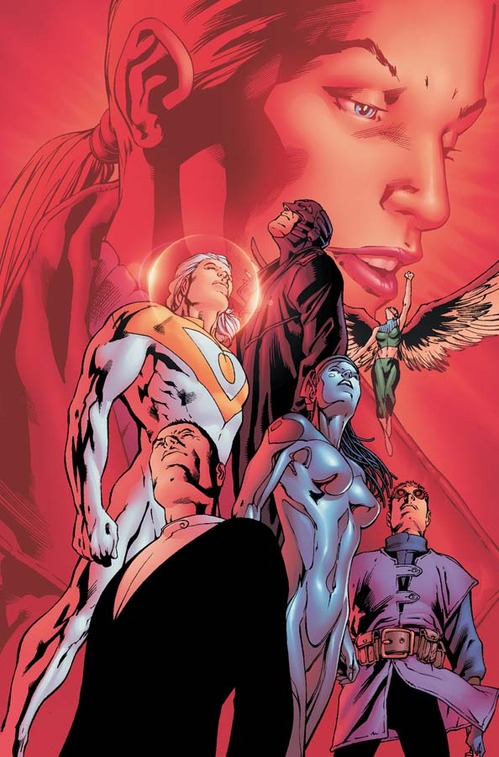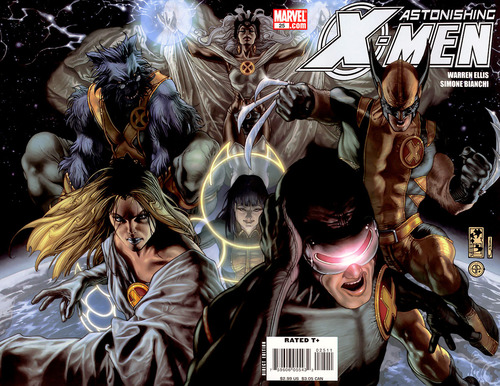The Warren Ellis Primer: Navigating The Wild Storm Architect’s Massive Comic Library
Main Art by Jon Davis-Hunt Comics Features Warren Ellis
 Warren Ellis is arguably the comic industry’s greatest living science-fiction writer. Along with contemporary Garth Ennis, the scribe led the second wave of the “British Invasion” to the beachhead of mainstream American comics in the ‘90s, changing the topography of the sequential-art world permanently. Since then, Ellis has proven himself time and time again, with successes big and small, mainstream and fringe. He possesses a singular voice that rides a careful line between biting cynicism and the optimism of the human spirit. His insights on transhumanism, technology and culture have often proved prescient, although by his own account, Ellis doesn’t so much predict the future as reflect a hyperbolic vision of the present.
Warren Ellis is arguably the comic industry’s greatest living science-fiction writer. Along with contemporary Garth Ennis, the scribe led the second wave of the “British Invasion” to the beachhead of mainstream American comics in the ‘90s, changing the topography of the sequential-art world permanently. Since then, Ellis has proven himself time and time again, with successes big and small, mainstream and fringe. He possesses a singular voice that rides a careful line between biting cynicism and the optimism of the human spirit. His insights on transhumanism, technology and culture have often proved prescient, although by his own account, Ellis doesn’t so much predict the future as reflect a hyperbolic vision of the present.
Ellis’ newest work, The Wild Storm, with art from Jon Davis-Hunt, debuted last month and its sophomore chapter released this week. It’s an enjoyable, if somewhat standard, Ellis opener—aside from one hell of a exoskeletal transformation sequence—with clean, modern art from Hunt. The Wild Storm also marks the second instance in which Ellis has been hired to reinvigorate, or in this case reimagine, these characters (more on that later), this time in the form of a superheroes-as-corporate-operators techno-thriller. With its lethal, quippy protagonist, corporate espionage set-up, and well, robots,The Wild Storm #1 is a fine gateway drug into the Ellis oeuvre. But this comic is just the tip of the iceberg when it comes to the man once lovingly referred to as the “Internet Jesus.”
So in honor of Ellis’ newest endeavor, Paste Magazine presents the Warren Ellis Primer. For readers acquainted with the sardonic scribe’s work, this piece will serve as a succinct reminder of some of his best stories. And for newbies, this list offers a map through some of the best reading the comics medium can call its own, from an author who’s been producing since 1990.
![]()

Transmetropolitan Cover Art by Geof Darrow
Where to Start
Transmetropolitan is Warren Ellis and artist Darick Robertson’s magnum opus. The 60-issue series follows the trials of Spider Jerusalem, an infamous gonzo journalist whose fearless pursuit of the truth lands him in a series of (now) disturbingly familiar misadventures within the rabid cyber-punk borders of “The City.” Published in the late ‘90s/early aughties, the work is as topical as it’s ever been and all of Ellis’ signature moves are on display: a chain-smoking, highly intelligent protagonist; expansive world-building; zany sci-fi concepts and the blackest of black humors. Transmetropolitan features a transhumanist civil rights movement, malfunctioning replicators, bowel-disrupting ray guns and a commander-in-chief so nefarious as to beggar belief (well…until Donald Trump became president).
It’s also a comic book overflowing with heart and sincerity. Spider Jerusalem’s reporting may cover the sensationalism of genetically altered prostitutes or singularity-obsessed human/machine hybrids, but Jerusalem’s writing also lays bare the inequities of police brutality and political corruption, and details the unique quality of urban loneliness. If you want a comprehensive view of what Ellis is capable of or to enjoy one of the medium’s greatest works period, there is no better place to start.
In addition to hard sci-fi tales, Ellis has also written a slew of superhero comics, and Planetary rides a fine line between those two areas. Part Fantastic Four pastiche, part love letter to the heroes of pulp yore, Planetary is an archaeological dig into the fabric of fiction itself, illustrated with aplomb by John Cassaday. The book concerns the exploits of the “Archaeologists of the Impossible,” a team of superhumans (led of course by another self-serious chain smoker) tasked with uncovering the secret truths of the universe. As they unravel the book’s big mystery, they encounter analogues of Godzilla, the Shadow, Tarzan, Shazam and, at one point, the literal Batman in a one-shot crossover.
For more overt head-punching, turn your attention to Ellis and Stuart Immonen’s hilarious superhero send-up Nextwave: Agents of H.A.T.E.. Thunderbolts, with artist Mike Deodato Jr., is another strong option, an event spin-off that allowed the creative team to delve into the dark recesses of the supervillain mind. And, as we’ve mentioned before, Ellis and Declan Shalvey’s Moon Knight is one of the best solo Marvel runs in recent memory.

The Authority Cover Art by Bryan Hitch
Where to Go Next
While Ellis was writing Planetary at the end of the 20th century, he was also helming The Authority with artist Bryan Hitch. This comic is a 12-issue masterclass in action storytelling featuring a paramilitary group comprised of heroes with supreme destructive capability and very little oversight. Super-powered terrorists and alternate-Earth invasions are painted with a shade of realism, and, for better or worse, we get the feeling that if superheroes were ever actually out there saving us in our real world, they’d be more like the this team and less like the Justice League. This series is also notable for popularizing what is commonly referred to as the “widescreen” format, a technique now baked into the fabric of modern mainstream comics that features massive double-paged spread of chaos and action. And speaking of the modern mainstream, fans of Shane Black’s Iron Man 3 might want to take a look at Ellis and Adi Granov’s The Invincible Iron Man: Extremis.
The Authority wasn’t the first time Ellis fiddled with format or presentation in his work, and it certainly wouldn’t be the last. Not many established creators would choose to give their long-form comics away for free, but Ellis went pro bono with artist Paul Duffield for the webcomic FreakAngels in 2008. The story revolves around the lives of a group of telepathic, telekinetic 20-somethings living in a post-flood (possibly post-apocalyptic) London, as the small enclave they’ve staked out begins to crumble. This 864-page epic remains one of the few webcomics orchestrated by an A-list creator at the height of his powers. It solidified the cyber-medium for many who didn’t even know it existed and eventually went on to become profitable in collected print format. Duffield’s steampunk designs and manga-inflected linework also go a long way to differentiate this from Ellis’ main body of work.
And since this list is itself a result of The Wild Storm, it would be prudent to point out the existence of a book called StormWatch, the thematic/narrative source for the Authority and Planetary. The title introduced the key players that would go on to fill out the ranks of The Authority (and presumably whatever team eventually coalesces in The Wild Storm). This is also the comic that spawned Apollo and Midnighter, the Superman and Batman analogues who happen to be husband and husband. Ellis’ arrival on this book represented a sea change for the title, which began its life as one of many superficial Image Comics launches in the ‘90s. The StormWatch team, a group of international superheroes employed by the United Nations, enjoyed a greater deal of sophistication and characterization in Ellis’ stories—even when they fought Xenomorphs in their inevitable Aliens crossover in the pages of WildC.A.T.S./Aliens.
Once you’ve had your fill of the books above, make sure to check these as well: Fell (a moody detective series with Ben Templesmith), Global Frequency (a science-fiction paramilitary thriller that consists of twelve one-and-dones with a rotating slate of artists), Secret Avengers (a six-issue black-ops Avengers run with a similar set-up to Global Frequency) and Injection (Ellis and Moon Knight collaborator Declan Shalvey’s X-Files-esque exploration of British magical history and weaponized futurism). We’d also be remiss if we forgot to mention Ellis and Jason Masters’ take on pop culture’s favorite British super-spy in their two 007 books, VARGR & Eidolen.

Black Summer Cover Art by Juan Jose Ryp
Deep Cuts
While Warren Ellis has maintained consistent mainstream visibility for decades, he’s also operated in the shadows with smaller publishers, namely Avatar Press. Hidden gems like Black Summer with Juan Jose Ryp, a book that begins with the brutal murder of a thinly veiled George W. Bush; and Supergod with Garrie Gastonny, a tale of man-made superheroes who destroy the planet, offer Ellis with the safety off. Avatar places very few restrictions on their creators and it’s because of its “anything goes” approach that we also get the giddy ultra-violence of a book like Ellis and Ryp’s Wolfskin, which details the misadventures of a prehistoric Conan-like character who ingests magic mushrooms.
If gore-drenched fisticuffs and the end of the world as we know it aren’t your thing, may we then suggest Ellis and Colleen Doran’s Orbiter? This is Ellis on the other side of the spectrum, providing readers with a hopeful, elegiac science-fiction tale akin to 2001: A Space Odyssey.
Ellis was also responsible for an extremely underrated run on Ultimate Fantastic Four, relieving series creators Brian Michael Bendis and Mark Millar of their writing duties before eventually spinning off into the heady Ultimate Galactus trilogy.

Astonishing X-Men Cover Art by Simone Bianchi
What You Can Skip
While we recommend digging deeper and going beyond the books mentioned above, here are some Ellis stories you can take a pass on:
Avengers: Endless Wartime has the feel of a book written on autopilot. While it features solid linework from Mike McKone, the book never thrives, instead echoing some of Ellis’ earlier, better works. And while we’re on Marvel, don’t bother with Wolverine: Not Dead Yet (more like not dead enough), Astonishing X-Men: Exogenetic (not to be confused with Astonishing X-Men: Xenogenesis, which was fun), and Astonishing X-Men: Ghost Boxes (not enough ghosts, too many boxes). And it’s best to avoid Ellis and Colton Worley’s Project Superpowers: BlackCross, part of Dynamite’s attempt to cash in on public-domain comic characters like the Black Terror and Lady Satan, whoever the hell those people are.
Jakob Free is a writer. He lives in New York and is not prepared for the impending apocalypse. You can find him online at jakobfree.com and @jakob_free.